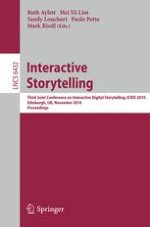2010 | Book
Interactive Storytelling
Third Joint Conference on Interactive Digital Storytelling, ICIDS 2010, Edinburgh, UK, November 1-3, 2010. Proceedings
Editors: Ruth Aylett, Mei Yii Lim, Sandy Louchart, Paolo Petta, Mark Riedl
Publisher: Springer Berlin Heidelberg
Book Series : Lecture Notes in Computer Science
